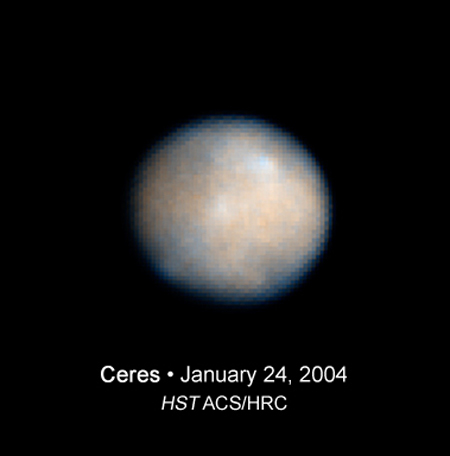Could Life on Earth Have Come From Ceres?

Astrobiologists hope to find life elsewhere in the universe, or possibly even in our own cosmic neighborhood, the solar system. Their efforts are usually concentrated on worlds such as the planet Mars, or icy moons like Europa. However, there are other, less conventional locations in the solar system where scientists think life may be found.
At the International Society for the Study of the Origin of Life conference in Florence, Italy, Joop Houtkooper from the University of Giessen divulged a theory that life could have originated on the asteroid Ceres.
The distant world Ceres, the smallest known dwarf planet in the solar system, lies within the asteroid belt. It was called a planet after its discovery in 1801, then later downgraded to asteroid status. With the latest planet definition from the International Astronomical Union, the round object is now considered a dwarf planet. Is there a chance that this exotic world is home to extraterrestrial organisms?
"This idea came to me when I heard a talk about all the satellites in the solar system that consist of a large part of ice, much of which is probably still in a liquid state," says Houtkooper. "The total volume of all this water is something like 40 times greater than all the oceans on Earth."
This reminded Houtkooper of a theory about how life originated. Organisms may have first developed around hydrothermal vents, which lie at the bottom of oceans and spew hot chemicals. Many icy bodies in our solar system have rocky cores, so they may have had or still have hydrothermal vents. Houtkooper realized, "if life is not unique to the Earth and could exist elsewhere, then these icy bodies are the places where life may have originated."
Looking at the evidence
Early in the history of the solar system was a period known as Late Heavy Bombardment, a turbulent time when cataclysmic asteroid impacts were common. If there was life on Earth before this dangerous era, it was most likely eradicated and had to begin again after much of this cosmic debris had cleared out of the inner solar system. Interestingly, evidence indicates that Ceres avoided being pummeled by devastating impacts during this time. If it had been bombarded, it would have completely and forever lost its water mantle, as its gravitational force is too weak to recapture it. This is probably what happened to the asteroid Vesta, which has a very large impact crater and no water.
"The evidence points to Ceres having remained relatively unscathed during the Late Heavy Bombardment," states Houtkooper. He says this means Ceres still could have "a water ocean where life could have originated early in the history of the solar system."
Breaking space news, the latest updates on rocket launches, skywatching events and more!
This leads to an interesting hypothesis. If the Earth was sterilized by colossal impacts, but Ceres hosted life which survived, could the dwarf planet have reseeded our world with life, via rock fragments that chipped off Ceres and then crashed into Earth? Are all organisms on Earth, including humans, descendants of Ceres? This is an idea that Houtkooper had to pursue.
"I looked at the different solar system bodies which either had or currently have oceans," he explains. "The planet Venus probably had an ocean early in its history, but the planet's greater mass means that more force is needed to chip off a piece of the planetary crust and propel it in the direction of the Earth. Smaller objects like Ceres have lower escape velocities, making it easier for parts of it to be separated."
Houtkooper then calculated the orbital paths of candidate planets, moons and asteroids to see which were in the best positions to have pieces successfully reach the Earth, without being intercepted by other objects. Ceres fared favorably in these calculations.
Life on Ceres
Finally, Houtkooper considered the possibility of organisms still being present on Ceres. "In the ocean, there could be life," he suggests. "On the surface, it would be more difficult. But there are some possibilities. There could be hydrogen peroxide-based life, able to withstand the low temperatures." It's not currently known whether hydrogen peroxide is present on Ceres, but nothing rules it out, either.
The thought of Earth being seeded with life from Ceres and creatures existing there today is certainly fascinating, but Houtkooper admits that it is more science fiction than science fact until evidence can be provided. This is naturally difficult to obtain, as Ceres is a small and distant world. Even the best current images contain very little detail, and just show that there are some surface features; what these features are exactly is a mystery. Spectral analyses indicate the presence of clay-like minerals, and Ceres' slightly flattened shape is what we would expect from a world with a rocky core below a layer of water or ice. Ceres is a dwarf planet with many secrets.
Fortunately, this will soon change thanks to NASA's Dawn mission. Launched in 2007, the probe is due to arrive at Ceres in 2015. Once there it will shed light on the mysterious world, and perhaps take photographs of geysers of water erupting from the surface. Its close-up view could indicate whether Ceres really does have the potential for life.

Lee Pullen is a science writer and communicator from the city of Bristol, UK. He has a degree in Astronomy and a master’s in Science Communication. He has written for numerous organizations, including the European Space Agency and the European Southern Observatory. In his spare time Lee enjoys taking photos of the night sky, and runs the website Urban Astrophotography.
